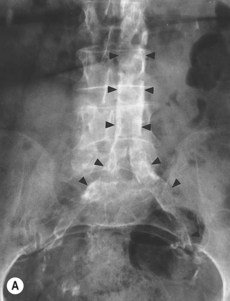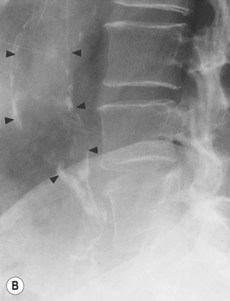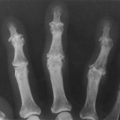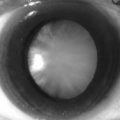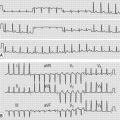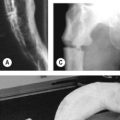123 Abdominal aortic aneurysm
Salient features
Examination
• Large expansile pulsation along the course of the abdominal aorta (examination for a pulsatile mass should be done by bimanual palpation of the supraumbilical area)
• Auscultate for bruit over the aneurysm and over the femoral pulses
• ‘Trash’ foot: digital infarcts in patient with easily palpable pulses (suggests either a popiliteal or abdominal aneursysmal source of emboli) (BMJ 2000;320:1193–6)
• Popliteal artery aneurysms often coexist and, in fact, their presence should prompt the physician to look for an abdominal aortic aneurysm.
• Ninety per cent of atherosclerotic abdominal aortic aneurysms present below the origin of the renal arteries and can involve the aortic bifurcation.
• The infrarenal aorta is normally 2 cm in diameter; when it exceeds 4 cm an aneurysm is said to exist.
• True arterial aneurysms are defined as 50% increase in the normal diameter of the vessel.
• Aneursymal process may affect any medium or large artery.
• The most commonly affected vessels are the aorta and iliac arteries, followed by popiliteal, femoral and carotid vessels.
Questions
Which investigations would you do to confirm your diagnosis?
• B mode ultrasonography of the abdomen: a simple, cheap and accurate screening test.
• Large aneurysms require angiography, but angiography may underestimate the size of lumen because of large clots.
• MRI is useful, particularly as it does not require administration of contrast.

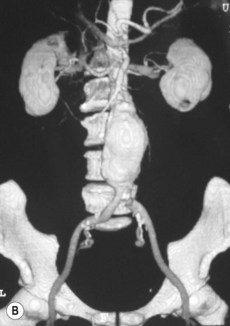
Fig. 123.1 An infrarenal abdominal aortic aneurysm by CT (A) and in three-dimensional CT reconstruction.
(With permission from Bhangu, Keighley 2007.)
Remember: Plain abdominal radiography shows a calcified aneursymal aortic wall in only half the cases (Fig. 123.2).
Advanced-level questions
How would you manage an abdominal aneurysm?
<4.5 cm: follow-up with ultrasonography every 6 months
4.5–5.0 cm: follow-up with ultrasonography every 3 or 6 months
5.0–5.5 cm: surgery or follow-up
>5.5 cm: pooled data suggest there is a high risk of rupture and hence patients should be referred for surgery if there are no confounding factors that increase the risk of surgery.
What are the types of abdominal aortic aneurysm?
• Aneurysms are usually classified into true, false and dissecting aneurysms.
• The Crawford classification defines into four types by anatomic location and extent of involvement:

